Experimental and Numerical Investigation of the Mesoscale Size Effect in Notched Woven Composites
Abstract
1. Introduction
2. Materials and Methods
2.1. Material and Mechanical Testing
2.2. Numerical Model
2.3. Data-Driven Calibration of Material Properties
2.3.1. Optimization of the Elastic Properties
2.3.2. Failure Properties
- 1.
- The stresses causing failure are longitudinal stress and shear stress ;
- 2.
- In vertical tows (“fiber direction”), failure occurs by fiber breakage. The failure criterion is thus:
- 3.
- In horizontal tows (“matrix direction”), failure occurs by matrix failure due to tensile stresses combined with shear stresses. The failure criterion is thus:
3. Results
3.1. Experimental Results
3.2. Elastic Properties
3.3. Failure Properties
- 1.
- Stress concentration. The affected volume scales up with the hole diameter. This leads to an increased probability of encountering a weak point within the structure that causes premature failure, and, consequently, a decrease in load-bearing capability. Indeed, as observed in Table 3, the nominal strength of the notched specimen, which is the ratio between the maximum force and the nominal notched cross-section, decreases with the hole diameter. This effect can also be quantified by the ratio of the remote longitudinal stress —defined earlier—to the maximum longitudinal stress in the entire specimen .
- 2.
- Stress localization. Close to the hole, stress sharply rises in a very limited volume. This leads to an observed local increase in material strength. This effect can be described by the ratio between the longitudinal tensile strength of the material in the notched specimens —determined as per Section 2.3.2—to the same property in the unnotched specimen, indicated as .
4. Conclusions
Author Contributions
Funding
Institutional Review Board Statement
Informed Consent Statement
Data Availability Statement
Conflicts of Interest
References
- Hild, F.; Roux, S. Digital Image Correlation: From Displacement Measurement to Identification of Elastic Properties—A Review. Strain 2006, 42, 69–80. [Google Scholar] [CrossRef]
- Lanza Di Scalea, F.; Hong, S.S.; Cloud, G.L. Whole-Field Strain Measurement in a Pin-Loaded Plate by Electronic Speckle Pattern Interferometry and the Finite Element Method. Exp. Mech. 1998, 38, 55–60. [Google Scholar] [CrossRef]
- Pierron, F.; Green, B.G.; Wisnom, M.R. Full-Field Assessment of the Damage Process of Laminated Composite Open-Hole Tensile Specimens. Part I: Methodology. Compos. Part A Appl. Sci. Manuf. 2007, 38, 2307–2320. [Google Scholar] [CrossRef]
- Caminero, M.A.; Lopez-Pedrosa, M.; Pinna, C.; Soutis, C. Damage Monitoring and Analysis of Composite Laminates with an Open Hole and Adhesively Bonded Repairs Using Digital Image Correlation. Compos. B Eng. 2013, 53, 76–91. [Google Scholar] [CrossRef]
- Bazant, Z.P. Size Effect on Structural Strength: A Review. Arch. Appl. Mech. 1999, 69, 703–705. [Google Scholar]
- Pagnoncelli, A.P.; Tridello, A.; Paolino, D.S. Modelling Size Effects for Static Strength of Brittle Materials. Mater. Des. 2020, 195, 109052. [Google Scholar] [CrossRef]
- Awerbuch, J.; Madhukar, M.S. Notched Strength of Composite Laminates: Predictions and Experiments—A Review. J. Reinf. Plast. Compos. 1985, 4, 3–159. [Google Scholar] [CrossRef]
- Batista, A.; Tinô, S.; Fontes, R.; Nóbrega, S.; Aquino, E. Analytical, Experimental and Finite Element Analysis of the Width/Diameter Hole Ratio Effect in Vinylester/Carbon Hybrid Twill Weave Composites. Compos. Part C Open Access 2020, 2, 100033. [Google Scholar] [CrossRef]
- Tinô, S.R.L.; Fontes, R.S.; De Aquino, E.M.F. Theories of Failure Average Stress Criterion and Point Stress Criterion in Notched Fiber-Reinforced Plastic. J. Compos. Mater. 2014, 48, 2669–2676. [Google Scholar] [CrossRef]
- Fontes, R.S.; Bezerra, H.A.D.; De Batista, A.C.M.C.; Tinôa, S.R.L.; De Aquino, E.M.F. Failure Theories and Notch Type Effects on the Mechanical Properties of Jute-Glass Hybrid Composite Laminates. Mater. Res. 2019, 22, e20180269. [Google Scholar] [CrossRef]
- Sattar, S.; Pedrazzoli, D.; Zhang, M.; Kravchenko, S.G.; Kravchenko, O.G. Notched Tensile Strength of Long Discontinuous Glass Fiber Reinforced Nylon Composite. Compos. Part A Appl. Sci. Manuf. 2022, 163, 107217. [Google Scholar] [CrossRef]
- Ma, Z.; Chen, J.; Yang, Q.; Li, Z.; Su, X. Progressive Fracture Analysis of the Open-Hole Composite Laminates: Experiment and Simulation. Compos. Struct. 2021, 262, 113628. [Google Scholar] [CrossRef]
- Hallett, S.R.; Green, B.G.; Jiang, W.G.; Wisnom, M.R. An Experimental and Numerical Investigation into the Damage Mechanisms in Notched Composites. Compos. Part A Appl. Sci. Manuf. 2009, 40, 613–624. [Google Scholar] [CrossRef]
- Jočić, E.; Marjanović, M. Progressive Failure Analysis of Open-Hole Composite Laminates Using FLWT-SCB Prediction Model. Int. J. Mech. Sci. 2022, 227, 107407. [Google Scholar] [CrossRef]
- Anzelotti, G.; Nicoletto, G.; Riva, E. Mesomechanic Strain Analysis of Twill-Weave Composite Lamina under Unidirectional in-Plane Tension. Compos. Part A Appl. Sci. Manuf. 2008, 39, 1294–1301. [Google Scholar] [CrossRef]
- Bruno, L. Mechanical Characterization of Composite Materials by Optical Techniques: A Review. Opt. Lasers Eng. 2018, 104, 192–203. [Google Scholar] [CrossRef]
- Réthoré, J.; Muhibullah; Elguedj, T.; Coret, M.; Chaudet, P.; Combescure, A. Robust Identification of Elasto-Plastic Constitutive Law Parameters from Digital Images Using 3D Kinematics. Int. J. Solids. Struct. 2013, 50, 73–85. [Google Scholar] [CrossRef]
- Réthoré, J. A Fully Integrated Noise Robust Strategy for the Identification of Constitutive Laws from Digital Images. Int. J. Numer. Methods Eng. 2010, 84, 631–660. [Google Scholar] [CrossRef]
- He, T.; Liu, L.; Makeev, A. Uncertainty Analysis in Composite Material Properties Characterization Using Digital Image Correlation and Finite Element Model Updating. Compos. Struct. 2018, 184, 337–351. [Google Scholar] [CrossRef]
- Ogierman, W.; Kokot, G. Analysis of Strain Field Heterogeneity at the Microstructure Level and Inverse Identification of Composite Constituents by Means of Digital Image Correlation. Materials 2020, 13, 287. [Google Scholar] [CrossRef]
- ASTM D5766/D5766M-11(2018); Standard Test Method for Open-Hole Tensile Strength of Polymer Matrix Composite Laminates. American Society for Testing and Materials: West Conshohocken, PA, USA, 2011; 8p. [CrossRef]
- ASTM D3039/D3039M-17; Standard Test Method for Tensile Properties of Polymer Matrix Composite Materials. American Society for Testing and Materials: West Conshohocken, PA, USA, 2011; 13p. [CrossRef]
- Schreier, H.; Orteu, J.J.; Sutton, M.A. Image Correlation for Shape, Motion and Deformation Measurements: Basic Concepts, Theory and Applications; Springer Science & Business Media: New York, NY, USA, 2009; ISBN 9780387787466. [Google Scholar]
- Gutmann, H.M. A Radial Basis Function Method for Global Optimization. J. Glob. Optim. 2001, 19, 201–227. [Google Scholar] [CrossRef]
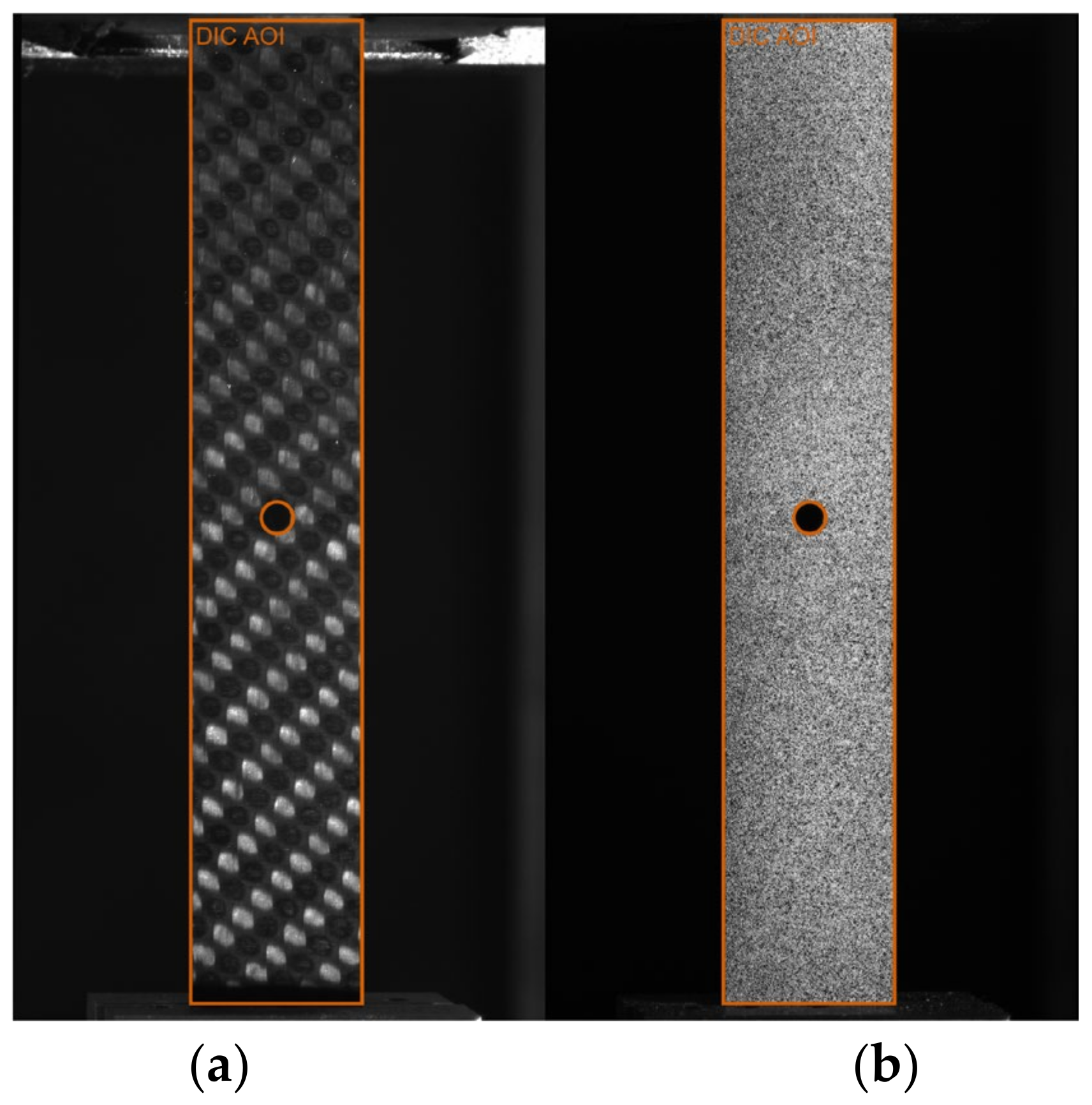


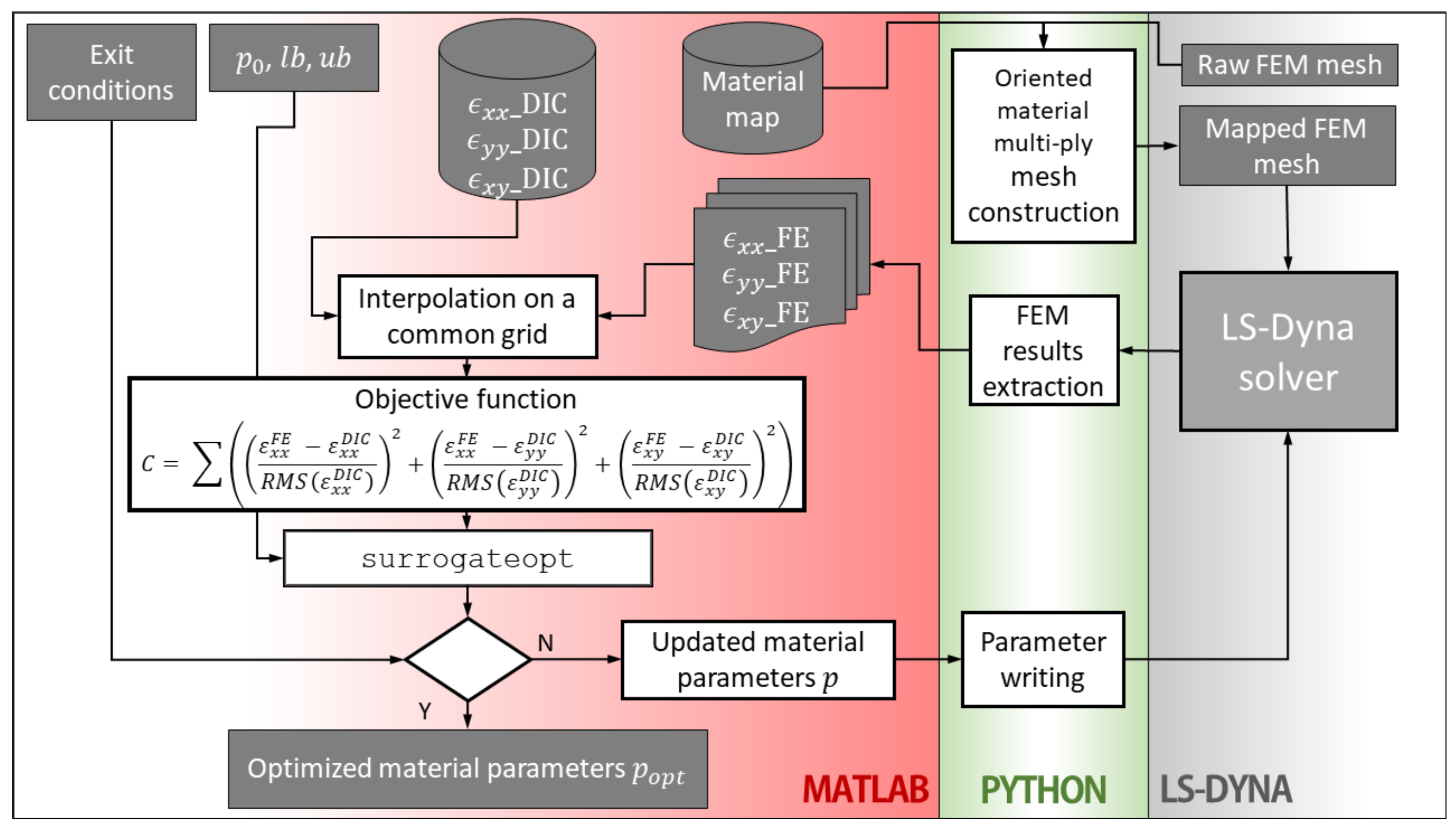
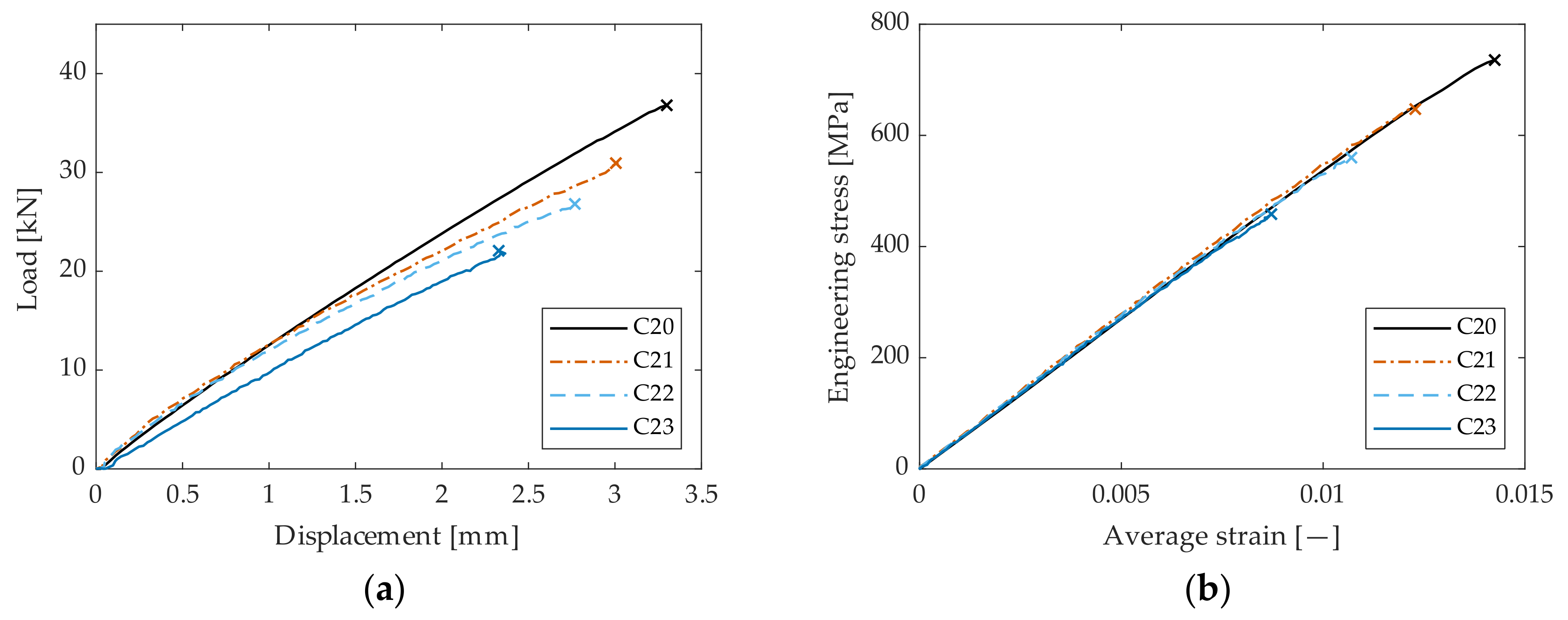
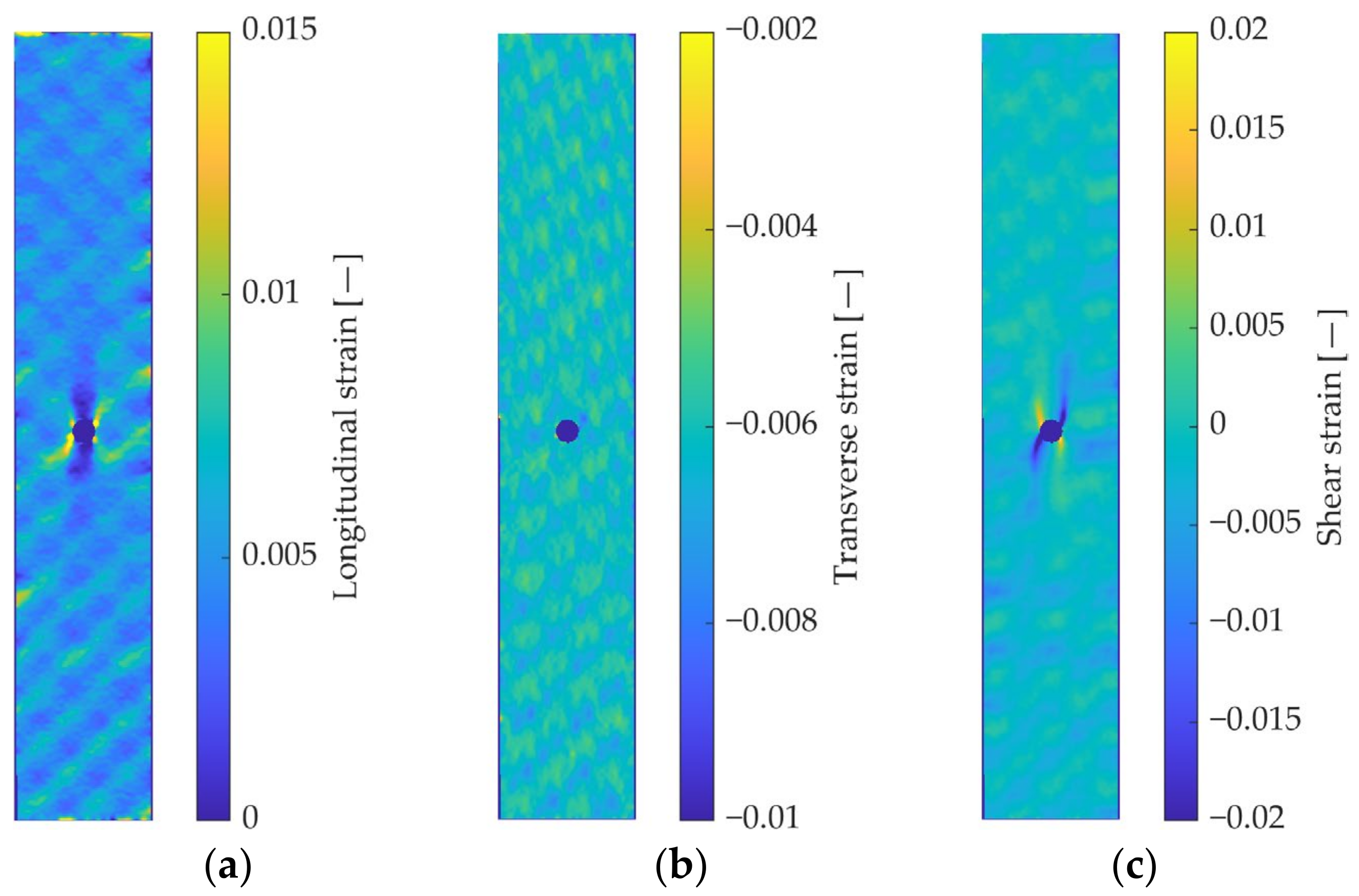
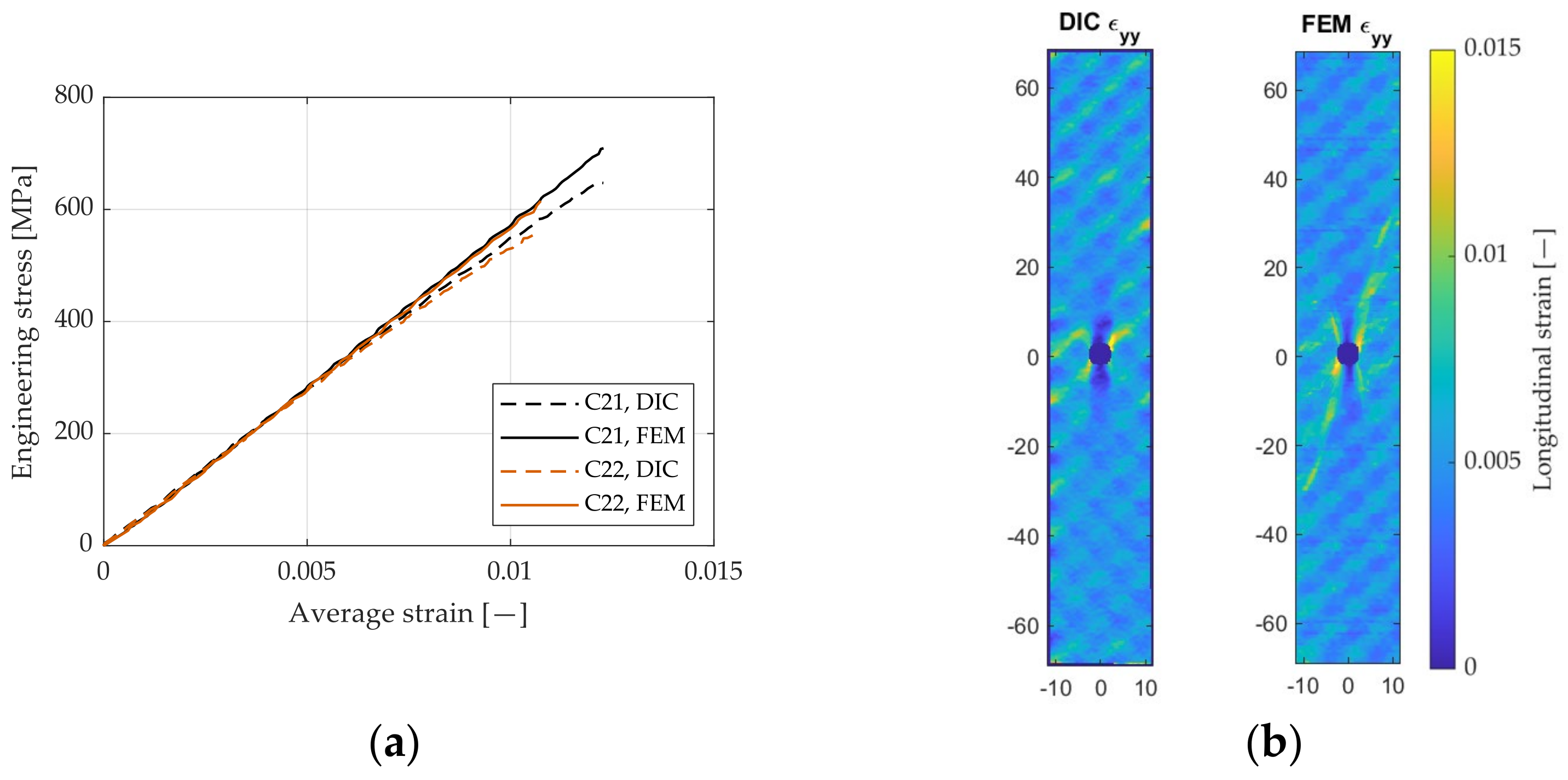

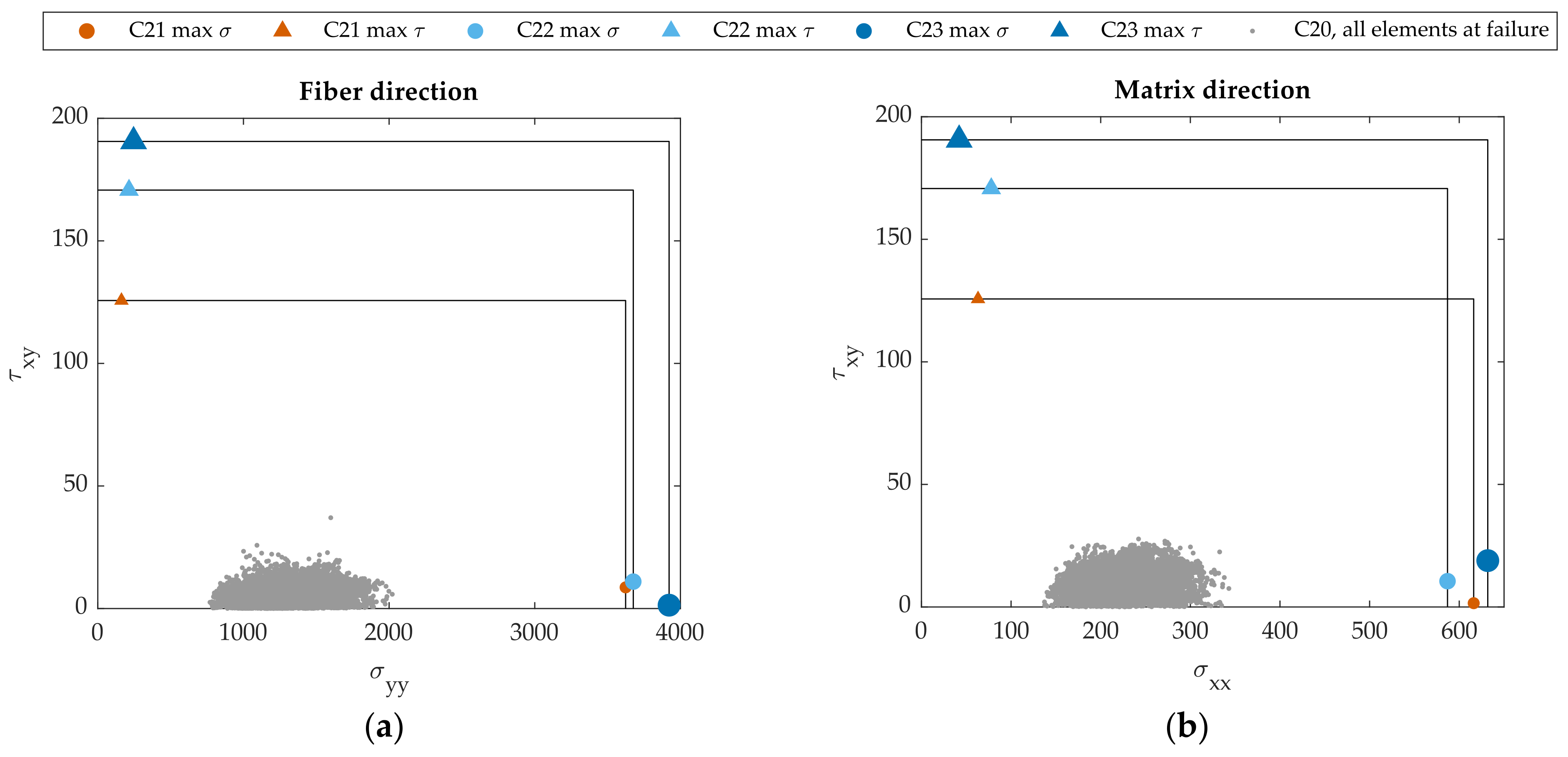

| Specimen | l [mm] | w [mm] | D [mm] |
|---|---|---|---|
| C20 | 250 | 24 | Unnotched |
| C21 | 250 | 24 | 2 |
| C22 | 250 | 24 | 4 |
| C23 | 250 | 24 | 8 |
| Specimen | UTSnom [MPa] | UTSnet [MPa] | ||||
|---|---|---|---|---|---|---|
| Mean | St. Dev. | CoV% | Mean | St. Dev. | CoV% | |
| C20 | 732 | 16.7 | 2.28 | — | — | — |
| C21 | 646 | 3.0 | 0.46 | 704 | 3.2 | 0.45 |
| C22 | 543 | 14.4 | 2.65 | 652 | 17.4 | 2.67 |
| C23 | 445 | 12.5 | 2.81 | 668 | 18.8 | 2.81 |
| Property | [GPa] | [GPa] | [GPa] | |
|---|---|---|---|---|
| Mean | 102.388 | 15.519 | 1.891 | 0.050 |
| St. dev. | 2.504 | 0.905 | 0.093 | 0.001 |
| CoV% | 2.45 | 5.83 | 4.93 | 1.15 |
| Specimen | [MPa] | [MPa] | [MPa] |
|---|---|---|---|
| C20 | 2131 | 370 | 117 |
| C21 | 3623 | 616 | 125 |
| C22 | 3676 | 586 | 170 |
| C23 | 3922 | 631 | 190 |
| Specimen | Volume 1 [mm3] | Volume 2 [mm3] | Total Volume [mm3] |
|---|---|---|---|
| C21 | 5.65 | 4.33 | 9.99 |
| C22 | 15.51 | 8.99 | 24.50 |
| C23 | 82.61 | 60.96 | 143.57 |
Disclaimer/Publisher’s Note: The statements, opinions and data contained in all publications are solely those of the individual author(s) and contributor(s) and not of MDPI and/or the editor(s). MDPI and/or the editor(s) disclaim responsibility for any injury to people or property resulting from any ideas, methods, instructions or products referred to in the content. |
© 2023 by the authors. Licensee MDPI, Basel, Switzerland. This article is an open access article distributed under the terms and conditions of the Creative Commons Attribution (CC BY) license (https://creativecommons.org/licenses/by/4.0/).
Share and Cite
Ferrarese, A.; Boursier Niutta, C.; Ciampaglia, A.; Ciardiello, R.; Paolino, D.S.; Belingardi, G. Experimental and Numerical Investigation of the Mesoscale Size Effect in Notched Woven Composites. Appl. Sci. 2023, 13, 4300. https://doi.org/10.3390/app13074300
Ferrarese A, Boursier Niutta C, Ciampaglia A, Ciardiello R, Paolino DS, Belingardi G. Experimental and Numerical Investigation of the Mesoscale Size Effect in Notched Woven Composites. Applied Sciences. 2023; 13(7):4300. https://doi.org/10.3390/app13074300
Chicago/Turabian StyleFerrarese, Andrea, Carlo Boursier Niutta, Alberto Ciampaglia, Raffaele Ciardiello, Davide S. Paolino, and Giovanni Belingardi. 2023. "Experimental and Numerical Investigation of the Mesoscale Size Effect in Notched Woven Composites" Applied Sciences 13, no. 7: 4300. https://doi.org/10.3390/app13074300
APA StyleFerrarese, A., Boursier Niutta, C., Ciampaglia, A., Ciardiello, R., Paolino, D. S., & Belingardi, G. (2023). Experimental and Numerical Investigation of the Mesoscale Size Effect in Notched Woven Composites. Applied Sciences, 13(7), 4300. https://doi.org/10.3390/app13074300












